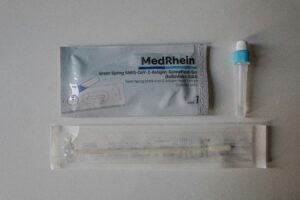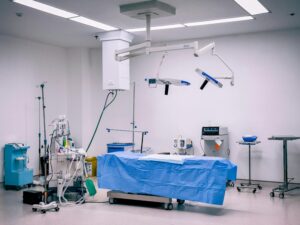UDI labelling is not only a mandatory requirement but also a key factor in maintaining competitiveness. Currently, the healthcare industry requires precise adherence to regulatory standards and agility across various production stages.
Why Border Manufacturing Gives OEMs Strategic Advantage
Each delay impacts compliance with UDI labelling regulations. One of the main challenges for medical device manufacturers is reducing the time between fabrication and delivery in the U.S.
Consequently, manufacturing in a geographic location near the country’s border enables shorter delivery times, reducing them from weeks to days. Thus, this geographical proximity to the distribution point eliminates long international transit times and reduces logistics costs.
Additionally, it facilitates communication, making it more agile among production, quality control, and distribution teams.
Strategic Positioning: Manufacturing in, Delivery at El Paso
In the competitive market for UDI-labelled medical devices, geographic location can mean the difference between success and failure. RexMed’s dual-site model, which combines manufacturing in Ciudad Juárez with strategic distribution from El Paso, offers OEMs a comprehensive solution by ensuring:
- Continuity in the manufacture. The manufacturing plants in Juárez meet the highest regulatory standards, including clean rooms and validated processes, as well as ISO packaging.
By combining high-quality manufacturing in Mexico with ultra-fast distribution from the U.S., RexMed offers OEMs the best of both worlds: competitive costs without sacrificing speed or regulatory consent.
From Cleanroom to Customs: A Coordinated Workflow
In the manufacturing of medical devices bearing the UDI label, operational efficiency does not end at the production line. By seamlessly integrating all stages, from cleanroom manufacturing to customs clearance, we achieve a real competitive advantage.
In this case, RexMed has refined its workflow to offer OEMs a seamless value chain that ensures product compliance, OEM traceability, and expedited delivery.
Manufacturing under regulatory standards
The process begins in ISO class 7 and 8 clean rooms, where the process consists of the following:
- Integrated quality control. Each component of the creation undergoes three checkpoints before assembly.
- UDI labelling. Pieces of equipment receive a unique identification from the first stage of fabrication.
- Automated documentation. MES (Manufacturing Execution Systems) creates digital records that ensure the correct path of the OEM.
Assembly and packaging
This is the critical phase where it is mandatory to comply with multiple requirements demanded by law:
- Regulatory labelling in which the manufacturer validates the different packaging parameters.
- Complete medical kit that includes devices, accessories, and support materials.
- Final verification of the labelling with automated scanning of each unit.
With the machine vision system, the company detects labelling inconsistencies with 99.97% accuracy, exceeding FDA requests.
Smart border logistics
In the healthcare industry, every hour of supply chain delay impacts patients and the bottom line. RexMed’s smart cross-border logistics redefines efficiency principles, combining advanced technology with optimized physical operations to overcome obstacles with our logistics differential:
- Customs pre-clearance. Electronic documentation is prepared 72 hours before physical shipment.
- Dedicated bridge shuttle. Exclusive fleet between Juárez and El Paso with temperature control.
- Real-time tracking. OEMs monitor each shipment through our web portal.
- Tangible benefit. Border crossing time has been reduced to an average of 3.8 hours, compared to the traditional 2.5 days.
Cross-border logistics is no longer an obstacle, but a strategic advantage when operating with RexMed’s intelligent model.
Risk mitigation in distribution
Medical device manufacturers face constant supply chain challenges, including logistics delays, regulatory changes, and demand fluctuations. Localized distribution emerges as the strategic solution to reduce risks and ensure reliable deliveries by applying the following:
- Simplified export management with bilingual teams and knowledge of border regulations that streamline customs procedures.
- Rapid response to changes, as proximity allows inventory adjustments and faster order dispatch.
- RexMed’s workflow transforms the regulatory complexity of medical products into a competitive advantage for OEMs by:
- Ensure device compliance at every stage
- Maintain impeccable OEM traceability
- Optimize mandatory labelling and packaging
- Reduce total cycle time versus traditional models
For equipment manufacturers that demand precision, speed, and complete fulfillment, our integrated model represents the ultimate solution.
Minimizing Risk with Localized Distribution
In the medical industry, failure to meet delivery deadlines generates the following:
- Regulatory risks. Delayed shipments can violate FDA UDI traceability requirements.
- Clinical disruptions. Most hospitals report cancelled procedures due to delays in the arrival of medical devices.
- Financial impact. Each day of reserve inventory increases the product cost.
The most effective solution to prevent this from happening is to do the following:
Dual Storage Network
In this case, the synchronization of both locations deals with integration that enables a rapid flow between manufacturing and distribution. We also have ISO 13485 certification, 100% UDI verification, and climate-controlled storage for sensitive devices.
Therefore, with all this, we reduce customs delays compared to traditional import standards.
Export Preparation Protocol
All manufactured products comply with standard protocols, but with the utmost attention to ensuring a thorough and dedicated process in the following areas:
- Pre-clearance. Use of FDA forms submitted electronically 72 hours before shipment, as well as UDI barcodes pre-scanned in AES (Automated Export System).
- Smart Packaging. Identification is delivered by authorities, along with location and temperature tracking using advanced technology.
Thus, the outcome is a first-time authorization rate near to 100% at U.S. ports of entry.
Serving U.S. OEMs with Agility and Control
UDI labelling of medical gear is a must-have for OEMs looking to fulfil guidelines and meet market demands. Hence, manufacturing close to the U.S. border, combined with a strategic logistics model, enables reduced distribution times, minimized risks, and adherence to high-quality criteria.
Moreover, American buyers look for providers that offer not only quality but also responsiveness. In this regard, RexMed meets these expectations by following the following requests:
- Bilingual coordination. Solid communication between technical, logistical, and regulatory teams.
- Reliable documentation. Flawless obedience with UDI labelling, ISO packaging, and traceability records.
- Consistent delivery. Reduced doubt in distribution times thanks to an improved logistics network.
Consequently, for OEMs, working with a closer and reliable company makes the difference in a highly regulated and competitive market.






